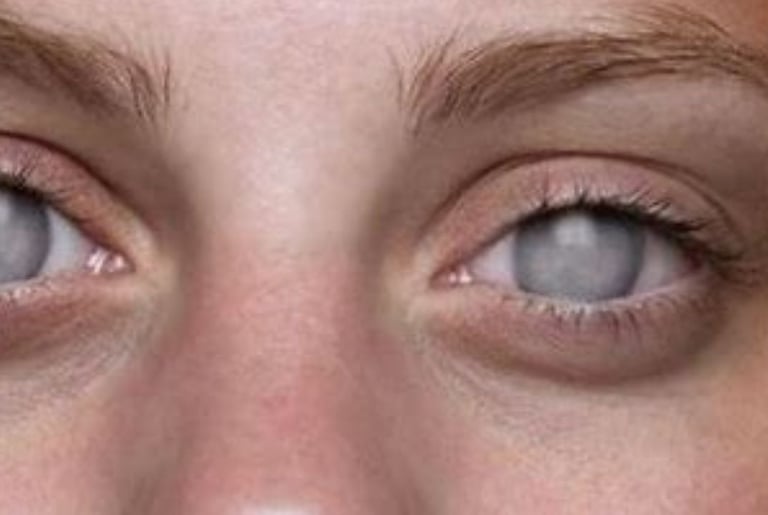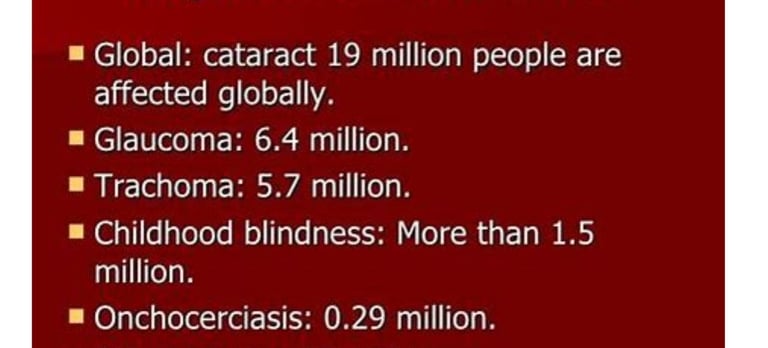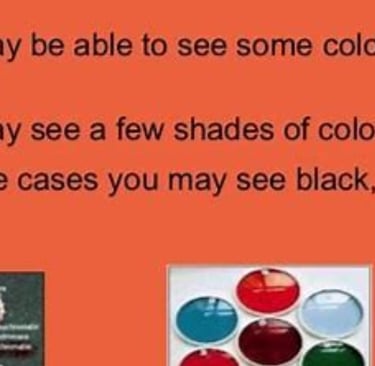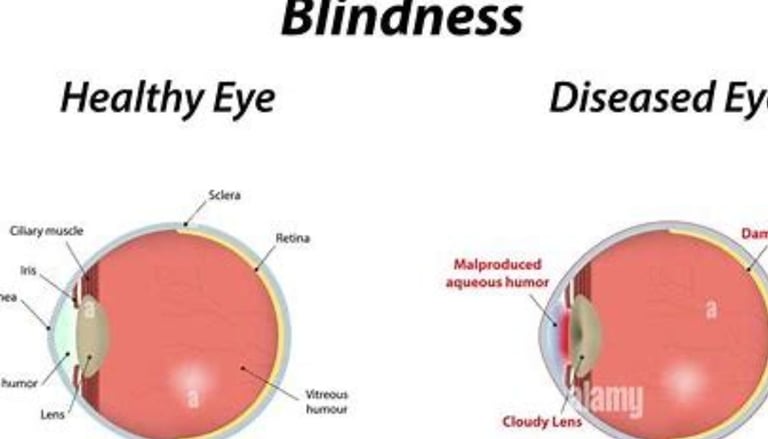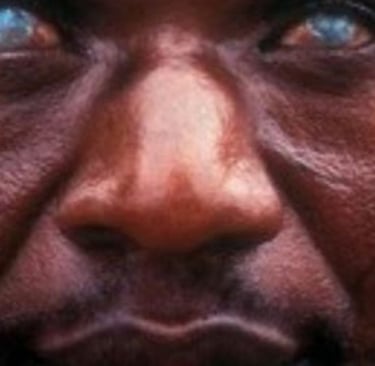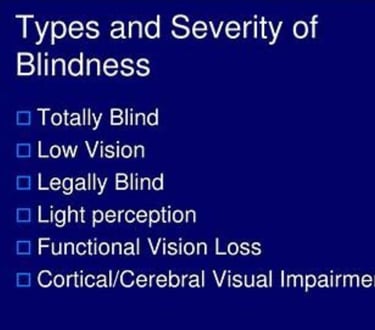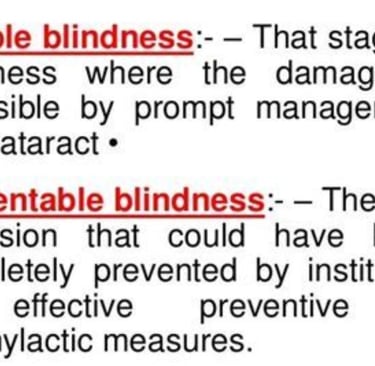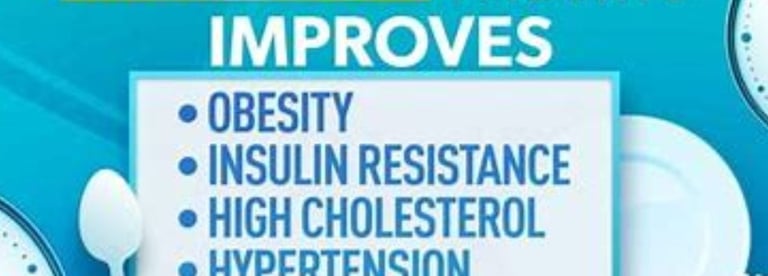
Health is a crown on the heads of the healthy that only the sick can see.

👁️ May Affect Anyone at Any Age: Macular Degeneration, Glaucoma & Cataracts
👁️ Macular Degeneration, Glaucoma & Cataracts: Not Just for the Elderly These vision-threatening conditions can affect people at any age. Learn the early signs, modern risk factors, and how to protect your eyes with natural and preventive care. 🧬🕶️
EYE DISEASE
Dr Hassan Al Warraqi
10/3/2023


👁️ May Affect Anyone at Any Age: Macular Degeneration, Glaucoma & Cataracts
👁️ Macular Degeneration, Glaucoma & Cataracts: Not Just for the Elderly
These vision-threatening conditions can affect people at any age. Learn the early signs, modern risk factors, and how to protect your eyes with natural and preventive care. 🧬🕶️
Blindness is the inability to see or a lack of vision.
In the most severe cases, there's an inability to see even light.
It also means that you can't correct your vision with eyeglasses, contact lenses, eye drops or other medical therapy, or surgery.
Blindness can happen to anyone, at any age.
It can be caused by a number of factors, including:
Birth defects: Some people are born with conditions that make them blind, such as cataracts, glaucoma, or retinopathy of prematurity.
Injury: Traumatic injuries to the eye can lead to blindness.
Disease: Diseases such as diabetes, macular degeneration, and glaucoma can cause blindness over time.
Medications: Some medications can have side effects that can lead to vision loss.
Exposure to toxins: Exposure to certain toxins, such as lead or mercury, can damage the eyes and lead to blindness.
Blindness can be classified as either total blindness or low vision.
Total blindness is the complete absence of sight.
Low vision is a condition in which vision is severely reduced, but not completely absent. People with low vision may have difficulty seeing objects clearly, or they may have difficulty seeing in low light or bright light.
There are millions of people in the world living with blindness.
Living with blindness
can be challenging, but it is possible to live a full and productive life.
There are a number of resources available to help blind people, including:
Assistive technology: Assistive technology devices can help blind people perform everyday tasks, such as reading, writing, and navigating their environment.
Support groups: Support groups can provide blind people with emotional support and practical advice.
Public awareness: Public awareness campaigns can help to educate people about blindness and the challenges that blind people face.
Blind people continue to make significant contributions to society today. They are doctors, lawyers, teachers, artists, and entrepreneurs. They are active members of their communities and they lead full and productive lives.
Acquired blindness
is the loss of vision that occurs after birth. It can be caused by a number of factors, including:
Eye diseases: Acquired blindness can be caused by a number of eye diseases, such as:
Cataracts: Clouding of the lens of the eye.
Glaucoma: Increased pressure in the eye that can damage the optic nerve.
Age-related macular degeneration: Degeneration of the macular, the central part of the retina.
Diabetes: Damage to the blood vessels in the retina.
Retinal detachment: Separation of the retina from the back of the eye.
Brain diseases: Brain diseases can also cause acquired blindness, such as:
Stroke: Damage to the blood vessels in the brain that can disrupt vision.
Multiple sclerosis: A disease that damages the myelin sheath that protects nerve fibers.
Parkinson's disease: A disease that damages nerve cells in the brain.
Traumatic brain injury: Damage to the brain that can disrupt vision.
Injury: Traumatic injuries to the eye can also lead to acquired blindness.
Acquired blindness can be sudden or gradual. It can affect one eye or both eyes. The severity of acquired blindness can vary from mild to severe.
Treatment for acquired blindness
depends on the underlying cause. For some eye diseases, such as cataracts and glaucoma, surgery can restore vision or prevent further vision loss.
For other eye diseases, such as age-related macular degeneration and diabetic retinopathy, there are treatments that can slow the progression of the disease and help to preserve vision loss .
For brain diseases that cause acquired blindness, there is no cure, but there are treatments that can help to manage the disease and improve quality of life.
Living with acquired blindness
can be challenging, but it is possible to live a full and productive life. There are a number of resources available to help people with acquired blindness, including:
Assistive technology
Support groups
Public awareness
People with acquired blindness can continue to work, go to school, and participate in their communities. With the right support and resources, people with acquired blindness can live full and meaningful lives.
Treatment
for acquired blindness depends on the underlying cause. Some of the most common treatments include:
Cataract surgery: Cataract surgery is a routine procedure that can remove a cloudy lens and replace it with a clear artificial lens. Cataract surgery is very successful and can restore vision in most cases.
Glaucoma surgery: There are a number of different glaucoma surgeries that can help to lower eye pressure and prevent further vision loss. Glaucoma surgery is not always successful, but it can help to preserve vision and prevent blindness.
Age-related macular degeneration (AMD) treatments: There are a number of different treatments available for AMD, including medications, laser therapy, and surgery. These treatments can help to slow the progression of the disease and preserve vision.
Diabetic retinopathy treatments: There are a number of different treatments available for diabetic retinopathy, including medications, laser therapy, and surgery. These treatments can help to prevent vision loss and blindness.
Retinal detachment surgery: Retinal detachment surgery is a complex procedure that involves reattaching the retina to the back of the eye. Retinal detachment surgery is very successful in most cases, but it is important to seek treatment as soon as possible to avoid permanent vision loss.
For brain diseases that cause acquired blindness, there is no cure, but there are treatments that can help to manage the disease and improve quality of life. These treatments may include medications, surgery, and rehabilitation therapy.
fasting
represent a big hope in the prevention and in treatment
i mean the islamic fasting to be tried first in diaseases which is tretable like cataract glaucoma toxins diabetic retiopathy macular degenration and brain diseases Retinal detachment etc
this is imporant in very poor communitis treatment for all the diseases in all ages all conditions
no time limit fasting as long as you can
donot miss this priceless hope
key words
Blindness ,anyone , any age , Birth defects , Injury , Disease , Medication ,Toxins ,Diabetic Retinopathy ,Age-related macular degeneration , Retinal detachment , Glaucoma , Cataract , Brain diseases ,
Visual Impairment and Accessibility Services
A Comprehensive Guide to Enhancing Quality of Life
This article aims to provide an in-depth exploration of visual impairment, focusing on its definitions, causes, challenges faced by individuals with visual disabilities, and the accessibility services available to support them.
It also highlights the regulatory frameworks and initiatives in Saudi Arabia and Egypt, optimized for search engine optimization (SEO) to reach the target audience effectively.
1. What is Visual Impairment? Definitions and Causes
Legal Blindness Definition:
In the United States, legal blindness is defined as a visual acuity of 20/200 or worse in the better eye after correction, or a visual field restricted to less than 20 degrees.
Many legally blind individuals can still distinguish shapes and shadows.
Visual Impairment: Refers to individuals with mild to severe vision loss.
Few are completely blind, and conditions vary, including loss of central or peripheral vision, clouded vision, or patchy vision.
Causes of Visual Impairment:
Retinal Issues: Corneal damage from infections (e.g., herpes keratitis) or vitamin A deficiency.
Optic Nerve or Brain Damage: Impairs signal transmission from the eye to the brain.
Chronic Diseases: Such as diabetes (diabetic retinopathy) and glaucoma.
Aging: Including cataracts and age-related macular degeneration.
Injuries: Trauma to the eye or head.
Genetic Conditions: Congenital disorders causing early vision loss.
Other Factors: Environmental pollution (common in Egypt), amblyopia, or surgical complications.
Keywords: Visual impairment, legal blindness, causes of vision loss, glaucoma, diabetic retinopathy.
2. Accessibility Services: Empowering Individuals with Visual Impairment
What Are Accessibility Services?
Accessibility services remove barriers that prevent individuals with disabilities from performing their tasks, such as modifying workplaces, providing assistive devices, or adjusting work methods.
Principles of Accessibility Services:
Ensure equal opportunities without discrimination.
Offer "reasonable" solutions aligned with organizational resources.
Consult individuals with visual impairments to understand their needs accurately.
Examples of Accessibility Services:
Assistive Technology: Screen readers, magnification software, braille displays, scanners for digitizing text.
Workplace Modifications: High-contrast signage, appropriate lighting, tactile markers, materials in accessible formats (braille, large print, MP3).
Work Arrangements: Scheduled breaks, flexible hours, or remote work options.
Best Practices:
Involve individuals in solution design.
Respect privacy.
Avoid assumptions about capabilities.
Clearly define job responsibilities.
Keywords: Accessibility services, assistive technology, workplace modifications, empowering people with disabilities.
3. Employment and Recruitment: Ensuring Fair Opportunities
Avoid Assumptions: Do not prejudge applicants’ abilities based on their visual impairment.
Appropriate Questions: Avoid health or disability-related questions before a job offer unless directly tied to role requirements or accessibility needs during recruitment.
Job Advertisements: Use clear fonts (16pt for Arabic, 14pt for English), accept applications in alternative formats, and provide contact details for accessibility support.
Interviews: Provide information in accessible formats, arrange rooms for easy navigation, and train reception staff.
Tests: Ensure tests do not disadvantage visually impaired candidates by offering alternative formats, extra time, or exemptions if necessary.
Keywords: Hiring people with disabilities, fair interviews, inclusive job ads.
4. Employee Retention: Continuous Support
Immediate Accessibility Services: Collaborate with employees and managers to implement agreed accommodations.
Regular Reviews: Assess the ongoing effectiveness of accommodations.
Training Opportunities: Provide professional development in accessible formats.
Disability Awareness: Train teams on interacting with visually impaired colleagues.
Keywords: Employee support, inclusive training, disability awareness.
5. Braille: A Key Empowerment Tool
What is Braille?
A tactile writing system using raised symbols, enabling blind individuals to read and write.
Importance: Bridges educational gaps for the blind, enhancing literacy and job prospects.
Evolution: Adapted from a military code, simplified to a 6-dot system for ease of use.
Applications: Used on currency, building signs, and medication labels.
Challenges: Declining use in some countries due to costs and technological advancements.
Arabic Braille: Developed in the mid-19th century with a standardized symbol system.
World Braille Day: Celebrated on January 4.
Keywords: Braille language, education for the blind, tactile symbols.
6. Regulatory Framework in Saudi Arabia
International Level:
Saudi Arabia ratified the UN Convention on the Rights of Persons with Disabilities (2008), ensuring equal work rights and reasonable accommodations.
National Level:
The Ministry of Labor and Social Development defines visual impairment as a disability requiring accessibility services.
The Disability Welfare System supports service provision.
Keywords: Disability rights, UN Convention, Taqat Saudi Arabia.
7. Visual Impairment in Egypt
Prevalence: Approximately 3.5 million Egyptians have visual impairments (2016/2017).
Challenges:
Daily Life: Limited awareness, access to healthcare, and transportation.
Education: Insufficient resources and assistive technology training.
Employment: Lack of job opportunities, discrimination, and inadequate support.
Initiatives:
Disability Rights Law (2018).
Support funds and rehabilitation centers.
Awareness campaigns and assistive technology provision.
Keywords: Visual impairment in Egypt, disability rights law, Egyptian initiatives.
8. Visual Impairment and Mental Health
Studies highlight a strong link between vision loss and mental health issues, as visual impairment significantly impacts well-being.
Providing psychological and social support is critical to improving quality of life.
Keywords: Mental health, disability support, vision loss impact.
Conclusion
Understanding visual impairment, its causes, and its challenges is essential for fostering inclusion.
Providing comprehensive accessibility services, promoting braille literacy, and enforcing regulatory frameworks in Saudi Arabia and Egypt are vital steps toward empowering visually impaired individuals.
Community awareness and mental health support further enhance their opportunities in education, work, and daily life.
Primary Keywords: Visual impairment, accessibility services, braille, disability rights, Saudi Arabia, Egypt
Legal Blindness, Causes, Accessibility Services, and Challenges
This article provides an in-depth exploration of legal blindness, its causes, accessibility services for the visually impaired, and the role of Braille in empowerment.
It also covers best practices for employing blind or visually impaired individuals, disability rights in Saudi Arabia, and the challenges and initiatives in Egypt.
Optimized for search engine optimization (SEO) with long-tail keywords, this content aims to reach audiences seeking information on supporting people with visual impairments.
1. What is Legal Blindness According to U.S. Standards?
Legal blindness in the United States is defined as:
Visual acuity of 20/200 or worse in the better eye, even with corrective lenses.
A visual field restricted to less than 20 degrees in the better eye.
Individuals classified as legally blind may still perceive shapes and shadows but struggle with details.
This definition determines eligibility for support and accessibility services.
Keywords: Legal blindness, U.S. definition of blindness, 20/200 visual acuity, restricted visual field.
2. What Are the Main Causes of Vision Loss or Impairment?
Vision loss or impairment can result from various factors, including:
Chronic Diseases:
Diabetic retinopathy: A complication of diabetes.
Glaucoma: Due to increased eye pressure.
Hypertension: Affects blood vessels in the eye.
Aging:
Cataracts: Clouding of the eye’s lens.
Age-related macular degeneration: Impacts central vision.
Injuries:
Trauma to the eye or brain.
Genetic Conditions:
Congenital disorders causing early vision loss.
Amblyopia (Lazy Eye):
Resulting from poor coordination between the eye and brain.
Refractive Errors:
Uncorrected nearsightedness or farsightedness.
Environmental Factors:
Pollution (prevalent in Egypt).
Lack of healthcare or malnutrition (e.g., vitamin A deficiency).
Keywords: Causes of vision loss, visual impairment, diabetic retinopathy, glaucoma, cataracts, environmental pollution.
3. What Are Accessibility Services, and How Do They Support the Blind or Visually Impaired in the Workplace?
Definition of Accessibility Services
Accessibility services are modifications or tools provided to individuals with disabilities to remove barriers hindering their ability to perform tasks. They enable blind and visually impaired individuals to work efficiently and ensure equality in the workplace.
“Accessibility services eliminate obstacles, empowering visually impaired individuals to succeed in their roles.”
Examples of Accessibility Services
Assistive Technology:
Screen readers (e.g., NVDA, JAWS).
Text-to-speech software.
Magnification screens and large-print keyboards.
Electronic Braille displays.
Scanners to convert printed text to digital formats.
Workplace Modifications:
Appropriate lighting and high-contrast signage.
Tactile markers and large-print labels.
Training materials in Braille, MP3, or large print.
Work Arrangements:
Scheduled breaks.
Flexible hours or remote work options.
Benefits of Accessibility Services
Enhance productivity and independence.
Foster an inclusive work environment.
Support retention of talented employees.
Keywords: Accessibility services, workplace support for the blind, assistive technology for visual impairment, inclusive work environment.
4. What is Braille, and How Does It Empower the Blind?
Definition of Braille
Braille is a tactile reading and writing system using raised dots, invented by Louis Braille in the 19th century.
It allows blind individuals to read and write independently.
Importance of Braille
Education: Essential for literacy among the blind.
Independence: Enables access to information without assistance.
Employment: Improves language skills and job opportunities.
Applications of Braille
Books and educational materials.
Public signage.
Currency and medication labels.
Musical and mathematical notation.
Evolution of Braille
Derived from a military code, it was simplified to a 6-dot system for ease of use. In Arabic, a standardized system was developed in the mid-19th century.
World Braille Day
Celebrated on January 4 to highlight its significance.
Keywords: Braille system, education for the blind, empowering visually impaired, World Braille Day.
5. Assistive Technologies for the Blind and Visually Impaired
A wide range of assistive technologies supports individuals with visual impairments, including:
Screen Readers: Convert text to speech or Braille (e.g., VoiceOver, TalkBack).
Magnification Software: Enlarges text and images.
Large Monitors and Keyboards: Simplify device interaction.
Electronic Braille Displays: Present text in Braille.
Scanners: Digitize printed text.
Smartphones with Accessibility Features: Voice output and large buttons.
Software Adjustments: Screen color changes, cursor size, or text contrast.
Keywords: Assistive technologies for the blind, screen readers, Braille displays, accessibility tools.
6. Rights and Legislation for Visually Impaired Individuals in Saudi Arabia
International Commitments
UN Convention on the Rights of Persons with Disabilities (2008): Saudi Arabia signed and ratified it, ensuring equal work rights and accessibility services.
National Legislation
Definition of Disability: The Ministry of Labor and Social Development includes visual impairment as a condition requiring support.
“Any person with a certified medical report confirming a permanent visual impairment is entitled to accessibility services.”
Labor Law: Prohibits discrimination and mandates inclusive workplaces.
Disability Welfare System: Supports services and rehabilitation.
Keywords: Disability rights in Saudi Arabia, accessibility services at work, Taqat, UN Convention.
7. Best Practices for Employing and Managing Blind or Visually Impaired Employees
Best practices for employers include:
Inclusive Job Advertisements:
Use positive language to encourage applications from people with disabilities.
Provide ads in alternative formats (Braille, audio).
Fair Recruitment Process:
Avoid unnecessary disability-related questions.
Ask candidates about their accessibility needs.
Accessible Interviews:
Arrange interview rooms for easy navigation.
Train reception staff to assist people with disabilities.
Post-Hiring Support:
Implement accessibility services immediately.
Conduct regular reviews to ensure accommodations remain effective.
Team Training:
Raise awareness about visual impairment.
Workplace Adjustments:
Use assistive technology and inclusive design.
Keywords: Hiring the blind, best practices for employment, inclusive workplace for disabilities.
8. Challenges Faced by Visually Impaired Individuals in Egypt and Efforts to Address Them
Challenges
Daily Life:
Lack of societal awareness.
Limited access to healthcare and transportation.
Social discrimination.
Education:
Shortage of materials in accessible formats (Braille, audio).
Insufficient training on assistive technology.
Employment:
Low awareness of the capabilities of the blind.
Limited job opportunities.
Lack of technological and professional support.
Egyptian Initiatives
Disability Rights Law (2018): Promotes inclusion and equality.
Disability Support Fund: Finances rehabilitation programs.
Training and Rehabilitation Centers: Build skills.
Awareness Campaigns: Aim to reduce discrimination.
Assistive Technology Provision: Includes screen readers and Braille devices.
NGO Support: Enhances service delivery.
Keywords: Challenges for visually impaired in Egypt, Disability Rights Law, initiatives for the blind in Egypt.
Conclusion
Visual impairment demands a thorough understanding of its definitions, causes, and associated challenges.
Providing effective accessibility services, promoting Braille literacy, and enforcing legislation in Saudi Arabia and Egypt are critical for empowering the blind and visually impaired.
By fostering awareness, leveraging assistive technology, and creating inclusive workplaces, societies can improve the quality of life for these individuals and ensure their full integration.
Primary Keywords: Visual impairment, legal blindness, accessibility services, Braille, disability rights in Saudi Arabia, support for the blind in Egypt.
👁️ Eye Diseases That May Affect Anyone at Any Age: Macular Degeneration, Glaucoma & Cataracts
Many people believe eye diseases only strike the elderly, but macular degeneration, glaucoma, and cataracts can affect individuals of any age—especially with modern lifestyle risk factors like screen overuse, poor nutrition, and chronic health conditions.
🧠 Quick Overview of Each Condition:
Eye DiseaseWhat It AffectsKey Symptoms🟡 Macular DegenerationCentral vision (macula)Blurred central vision, distortion🌀 GlaucomaOptic nerve (eye pressure-related)Loss of peripheral vision, eye pressure🌫️ CataractsEye lens (clouding)Hazy or blurry vision, night glare
⚠️ Who’s at Risk (Regardless of Age)?
📱 Screen-heavy lifestyles
🩸 High blood pressure or diabetes
🌞 Excess UV exposure
🧬 Family history of eye disease
🚬 Smoking or poor diet
Even teens and young adults are now being diagnosed earlier due to these environmental and lifestyle factors.
👓 Early Prevention Tips:
🥦 Eat antioxidant-rich foods (vitamins A, C, E, zinc, lutein)
🕶️ Wear UV-protective sunglasses outdoors
🛌 Get regular sleep to reduce eye stress
💧 Keep eyes hydrated and take screen breaks (20-20-20 rule)
🩺 Get eye checkups — even without symptoms
Expected H-K-E-M.com Author Information:
Primary Author: Dr. Hassan Al Warraqi
Email: hassanalwarraqi@h-k-e-m.com
Alternative Contact: hassan@h-k-e-m.com
Website Owner: Listed as "hakim"
Website Philosophy: "Health is a crown on the heads of the healthy that only the sick can see."
